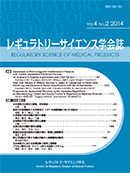Volume 4, Issue 3
Displaying 1-10 of 10 articles from this issue
- |<
- <
- 1
- >
- >|
-
2014Volume 4Issue 3 Pages 189-198
Published: 2014
Released on J-STAGE: January 15, 2015
Download PDF (737K) -
2014Volume 4Issue 3 Pages 199-206
Published: 2014
Released on J-STAGE: February 04, 2015
Download PDF (860K)
-
2014Volume 4Issue 3 Pages 207-213
Published: 2014
Released on J-STAGE: February 04, 2015
Download PDF (2436K) -
2014Volume 4Issue 3 Pages 215-221
Published: 2014
Released on J-STAGE: February 04, 2015
Download PDF (1776K) -
2014Volume 4Issue 3 Pages 223-230
Published: 2014
Released on J-STAGE: February 04, 2015
Download PDF (1015K) -
2014Volume 4Issue 3 Pages 231-235
Published: 2014
Released on J-STAGE: February 04, 2015
Download PDF (686K) -
2014Volume 4Issue 3 Pages 237-247
Published: 2014
Released on J-STAGE: February 04, 2015
Download PDF (823K)
-
2014Volume 4Issue 3 Pages 249-255
Published: 2014
Released on J-STAGE: February 04, 2015
Download PDF (911K)
-
2014Volume 4Issue 3 Pages 257-264
Published: 2014
Released on J-STAGE: February 04, 2015
Download PDF (773K)
-
2014Volume 4Issue 3 Pages 265-271
Published: 2014
Released on J-STAGE: February 04, 2015
Download PDF (730K)
- |<
- <
- 1
- >
- >|
